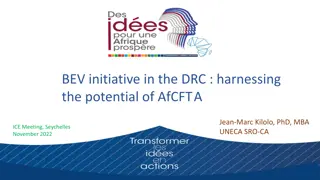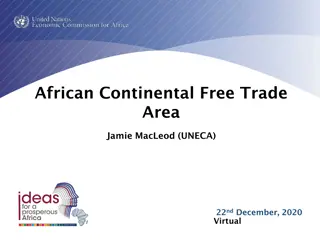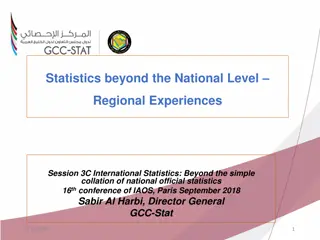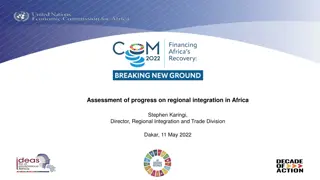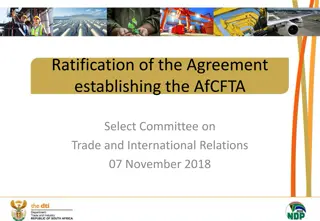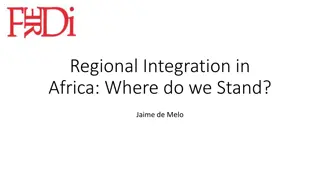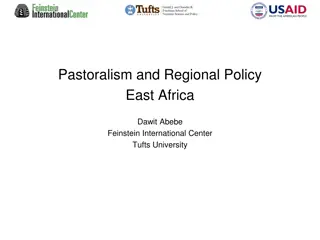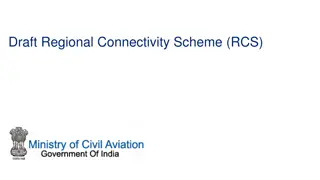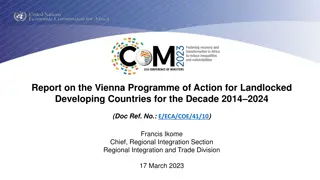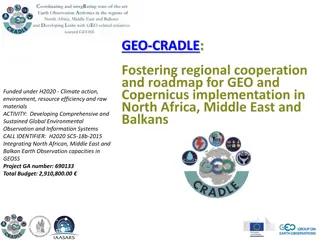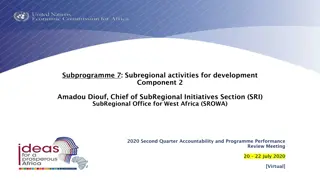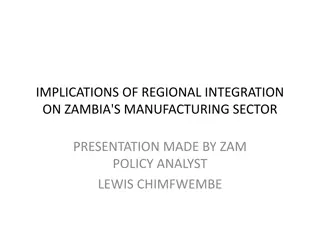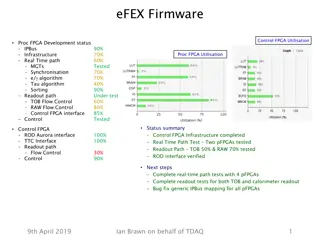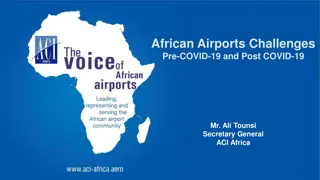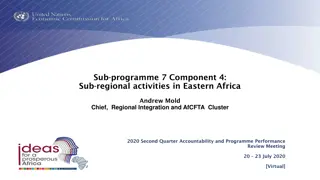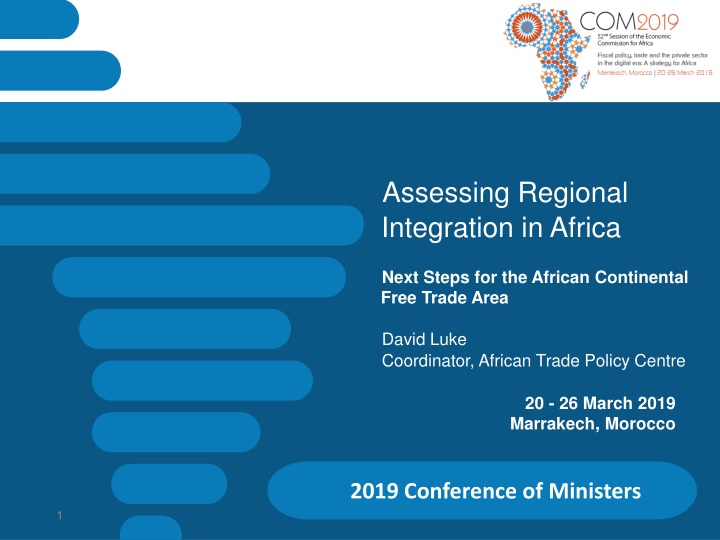
Assessing Regional Integration in Africa: Next Steps for AfCFTA
Assessment of regional integration in Africa, focusing on the status and challenges faced, particularly in monetary integration, trade, services, and free movement. The discussion includes recommendations to address implementation crises and the importance of energy and infrastructure integration. Updates on the African Continental Free Trade Area (AfCFTA) progress are also highlighted, emphasizing the positive welfare benefits it is forecasted to bring for all African countries. Recommendations for maximizing AfCFTA gains are proposed to optimize its impact on the continent's economy.
Download Presentation

Please find below an Image/Link to download the presentation.
The content on the website is provided AS IS for your information and personal use only. It may not be sold, licensed, or shared on other websites without obtaining consent from the author. If you encounter any issues during the download, it is possible that the publisher has removed the file from their server.
You are allowed to download the files provided on this website for personal or commercial use, subject to the condition that they are used lawfully. All files are the property of their respective owners.
The content on the website is provided AS IS for your information and personal use only. It may not be sold, licensed, or shared on other websites without obtaining consent from the author.
E N D
Presentation Transcript
Assessing Regional Integration in Africa Next Steps for the African Continental Free Trade Area David Luke Coordinator, African Trade Policy Centre 20 - 26 March 2019 Marrakech, Morocco 2019 Conference of Ministers 1
1| Status of regional integration 2 Status of regional integration in Africa Monetary integration actively pursed in 5/8 RECs: but insufficient progress in convergence indicators Trade: with the exception of SADC, intra-African trade remains low Services integration important: over 53% of Africa s GDP from services Gradual progress in free movement: but need to ratify AU Protocol Continuing integration challenges incl: limited energy and infrastructure development, overlapping membership of RECs; limited financial resources Recommendations: Address crisis of implementation by translating promises made at continental and regional levels into actions Importance of energy and infrastructure integration, and M&E (ARII) Assessing Regional Integration in Africa | Next Steps for the AfCFTA UNECA.ORG 2
1| Status of regional integration 3 Intra-African trade as a share of GDP 6% 5% 4% 3% 2% 1% 0% 2000 2001 2002 2003 2004 2005 2006 2007 2008 2009 2010 2011 2012 2013 2014 2015 2016 2017 AMU CEN-SAD COMESA EAC ECCAS ECOWAS IGAD SADC Assessing Regional Integration in Africa | Next Steps for the AfCFTA UNECA.ORG 3
2| State of play on the AfCFTA 4 Status update on the AfCFTA Remarkable progress: 52/55 AU MS signed with 19 having ratified. Text concluded on all 4 Protocols and 10 of the 12 annexes: Schedules of Concessions and RoO July 2019 deadline, specific commitments in services by end-2019 deadline ECA AfCFTA forecast to have positive welfare benefits for all African countries without exception: boosting total GDP and exports of Africa Recommendations: Remaining AU MS should promptly ratify without delay Rapidly conclude remaining technical work Follow entry into force with effective implementation Assessing Regional Integration in Africa | Next Steps for the AfCFTA UNECA.ORG 4
3| Maximizing the AfCFTA gains 5 Taking full advantage of the AfCFTA Countries must buttress its implementation with complementary measures, within dedicated national AfCFTA Strategies, to support: Investment: with, inter alia targeting AfCFTA market; matchmaking between international and domestic firms; and one-stop-shops for investment Productive capacity: a) use industrial policy to create supportive enabling environment; b) use sector-specific strategies with regional focuses Trade facilitation: a) AfCFTA NTB mechanism; b) standards infrastructure; c) single windows / one-stop border posts; e) AfCFTA Simplified Trade Regime Infrastructure: implement PIDA and use strategic logistics management Import defence: pool resources for regional trade remedy and competition institutions; ensure monitoring and evaluation of import trade flows Assessing Regional Integration in Africa | Next Steps for the AfCFTA UNECA.ORG 5
3| Maximizing the AfCFTA gains 6 Assessing Regional Integration in Africa | Next Steps for the AfCFTA UNECA.ORG 6
4| Challenges to the AfCFTA 7 Internal and external challenges to the AfCFTA AfCFTA explicitly aspires towards deeper integration: stated objective to lay the foundation for the establishment of a Continental Customs Union Care must be taken so that AfCFTA does not add an additional strand in the African spaghetti bowel of FTAs: should cohere trade policy landscape AfCFTA can provide a platform for a common approach to African trade relations with third countries Recommendations: Strengthen the ambition of the AfCFTA over the longer term to consolidate the RECs and realize a continental customs union Leverage AfCFTA as platform for negotiations with rest of world: reinforce a coherent African trade policy Assessing Regional Integration in Africa | Next Steps for the AfCFTA UNECA.ORG 7
5| Investment in the AfCFTA 8 AfCFTA Protocol on Investment Africa s investment landscape is fragmented: 854 BITs (512 in force), of which 169 are intra-African (44 in force) many overlapping and old generation , often with ISDS, vulnerable to treaty shopping, and policy space AfCFTA Protocol on Investment: Can be informed by the Pan-African Investment Code (PAIC) Cohere the African investment landscape Provide predictable, forward-looking and transparent rules Substantive obligations and dispute settlement provisions need to be revisited and aligned with African developmental needs Emphasis on investment promotion and facilitation, and dispute prevention Assessing Regional Integration in Africa | Next Steps for the AfCFTA UNECA.ORG 8
6| IPR in the AfCFTA 9 AfCFTA Protocol on Intellectual Property Rights Africa s IPR commitments are fragmented: 44 countries member to WTO TRIPs, others in different IP international agreements and FTAs with IPR 3 models proposed for integration in IPR: a) regional cooperation and sharing of experience, b) regional filing systems, c) unification of IP laws AfCFTA Protocol on IPR can: Provide guiding principles for national IP law and policy Develop norms to safeguard specific African interests (TK, PVP, culture) Provide regional IP exhaustion system to encourage RVCs Develop guidelines and procedures for the enforcement of IP rights Provide forum for cooperation between ARIPO and OAPI Assessing Regional Integration in Africa | Next Steps for the AfCFTA UNECA.ORG 9
7| Competition in the AfCFTA 10 AfCFTA Protocol on Competition Policy Africa s competition regime is patchy and incomplete: only 23 countries have competition laws enforced by competition authorities Competition drives growth: cartels, abuse of dominance, anti-competitive practices etc cross over borders and limit development in Africa AfCFTA framework for competition: can build on efforts undertaken at RECs, including EAC, ECOWAS, COMESA, CEMAC and WAEMU AfCFTA Protocol on Competition can: Provide substantive coverage of main competition issues Be enforced through: a) supranational AfCFTA competition body (eg COMESA/EAC/ECOWAS), b) supranational body and cooperation network (eg EU), or c) competition cooperation framework (eg SADC) Assessing Regional Integration in Africa | Next Steps for the AfCFTA UNECA.ORG 1 0
8| E-Commerce in Africa 11 E-Commerce in a Digitalizing Africa Active mobile-broadband subscriptions, per 100 inhabitants (2010-2017) Percentage of Individuals using the Internet, 5 biggest African economies 60.0 70.0 60.0 50.0 50.0 40.0 40.0 30.0 30.0 20.0 20.0 10.0 10.0 0.0 0.0 2000 2005 2010 2015 2016 2010 2011 2012 2013 2014 2015 2016 2017* Morocco South Africa Nigeria Africa LDCs Developing World Algeria Angola Assessing Regional Integration in Africa | Next Steps for the AfCFTA UNECA.ORG 1 1
8| E-Commerce in Africa 12 E-Commerce in a Digitalizing Africa E-commerce is changing African economies: worldwide e-commerce sales in 2016 reached $26tr, yet less than 5% of the population are using the internet in Niger, CAR, Guinea-Bissau, Somalia and Eritrea E-commerce policy landscape is evolving: cooperation in Africa can prevent digital barriers and inhibit the fracturing of Africa by tech giants Consistent digital rules in Africa: can create environment where firms (digital or not) can fairly compete and simplify the rules for e-commerce To foster regulatory cooperation on e-commerce, 3 options identified: Holistic African Digital Economy Strategy Integrating e-commerce perspectives into existing AU instruments E-commerce Protocol as an instrument within the AfCFTA Assessing Regional Integration in Africa | Next Steps for the AfCFTA UNECA.ORG 1 2
For more info, see: Upcoming ARIA IX Follow the conversation: #COM2019 More: www.uneca.org/cfm2019 1 3

